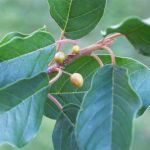| Common Name: |
Alder Dogwood |
| Other Names: |
Alder Dogwood, Black Alder, Black Dogwood, Frangula |
| Botanical Name: |
Rhamnus frangula syn. Frangula alnus |
| Genus: |
Rhamnus |
| Family: |
Rhamnaceae |
| Native Location: |
Europe, N Africa, and Russia |
| Cultivation: |
Well-drained soil in sun or partial shade. Rhamnus cathartica prefers alkaline soil, R. frangula neutral to acid soil. Shorten of thin out branches, and remove dead wood, in late winter or early spring. |
| Propagation: |
By seed sown when ripe; by greenwood cuttings in early summer; by layering in autumn or early spring. |
| Harvest: |
Bark is stripped from young plants during spring and early summer, and it is dried for one to two years before being used in decoctions, liquid extracts, powders, and tablets. Bark from two-year-old plants is preferred in the case of R. frangula. Fruits (R. cathartica) are collected when ripe and they are made into syrup. |
| Height: |
5m (15ft) |
| Width: |
3-5m (10-15ft) |
| Hardiness: |
Z2-9 |
| Parts Used: |
Inner bark |
| Properties: |
A bitter, astringent, antiseptic herb that stimulates the liver and gall bladder, and acts as a purgative. |
| Medicinal Uses: |
Internally for chronic, atonic constipation, abdominal bloating, hepatitis, cirrhosis, jaundice, and liver and gall bladder complaints. Externally for gum disease and scalp infections.
To treat hemorrhoids and poor digestion. Germany's Commission E has approved the use of frangula to treat constipation. |
| Typical Dose: |
A typical dose of frangula for constipation may range from 1 to 2 cups of frangula tea per day, using the smallest amount of herb needed to relieve symptoms. |
| Possible Side Effects: |
Frangula's side effects include loss of electolytes, particularly potassium, with long-term use. |
| Drug Interactions: |
Digoxin, Diuretics, Loop Diuretics, Oral Corticosteriods, Thiazide Diuretics.
| Taking frangula with these drugs may increase the risk of hypokalemia (low levels of potassium in the blood): |
| Acetazolamide, (Apo-Acetazolamide, Diamox Sequels) |
Azosemide, (Diat) |
Beclomethasone, (Beconase, Vanceril) |
Betamethasone, (Celestone, Diprolene) |
| Budesonide, (Entocort, Rhinocort) |
Budesonide and Formoterol, (Symbicort) |
Bumetanide, (Bumex, Burinex) |
Chlorothiazide, (Diuril) |
| Chlorthalidone, (Apo-Chlorthalidone, Thalitone) |
Cortisone, (Cortone) |
Deflazacort, (Calcort, Dezacor) |
Dexamethasone, (Decadron, Dexasone) |
| Ethacrynic Acid, (Edecrin) |
Etozolin, (Elkapin) |
Flunisolide, (AeroBid, Nasarel) |
Fluorometholone, (Eflone, Flarex) |
| Fluticasone, (Cutivate, Flonase) |
Furosemide, (Apo-Furosemide, Lasix) |
Hydrochlorothiazide, (Apo-Hydro, Microzide) |
Hydrocortisone, (Anusol-HC, Locoid) |
| Hydroflumethiazide, (Diucardin, Saluron) |
Indapamide, (Lozol, Nu-Indapamide) |
Mannitol, (Osmitrol, Resectisol) |
Mefruside, (Baycaron) |
| Methazolamide, (Apo-Methazolamide, Neptazane) |
Methyclothiazide, (Aquatensen, Enduron) |
Methylprednisolone, (Depo-Medrol, Medrol) |
Metolazone, (Mykrox, Zaroxolyn) |
| Olmesartan and Hydrochlorothiazide, (Benicar HCT) |
Polythiazide, (Renese) |
Prednisolone, (Inflamase Forte, Pred Forte) |
Prednisone, (Apo-Prednisone, Deltasone) |
| Torsemide, (Demadex) |
Triamcinolone, (Aristocort, Trinasal) |
Trichlormethiazide, (Metatensin, Naqua) |
Urea, (Amino-Cerv, UltraMide) |
| Xipamide, (Diurexan, Lumitens) |
| Taking frangula with these drugs may increase fluid and electrolyte loss: |
| Cascara, (Cascara) |
Docusate and Senna, (Peri-Colace, Senokot-S) |
| Taking frangula with this drug may be harmful: |
| Digitalis, (Digitek, Lanoxin)—May increase therapeutic and adverse effects of the drug. |
|
| Warning: |
All parts, especially the berries are harmful if eaten. Sap and berries are skin irritants. |
| Lab Test Alterations: |
May confound results of diagnostic urine tests that rely on a color change by discoloring urine (pink, red, purple, or orange). |
| Disease Effects: |
May worsen irritable bowel syndrome, Crohn's disease, and other intestinal ailments. |
| Supplement Interactions: |
Increased risk of potassium depletion when used with Licorice, Horsetail Plant, or other stimulant laxative herbs, such as Black Root, Cascara Sagrada, Castor Oil, and Senna. |
| Bibliography: |
Encylopedia of Herbs by Deni Brown Copyright ©: 1995, 2001 Dorling Kindersley Limited pp 342-343
The Essential Herb-Drug-Vitamin Interaction Guide by Geo. T. Grossberg,MD and Barry Fox,PhD. Copyright©2007 Barry Fox,PhD. Pp.227-228 |

